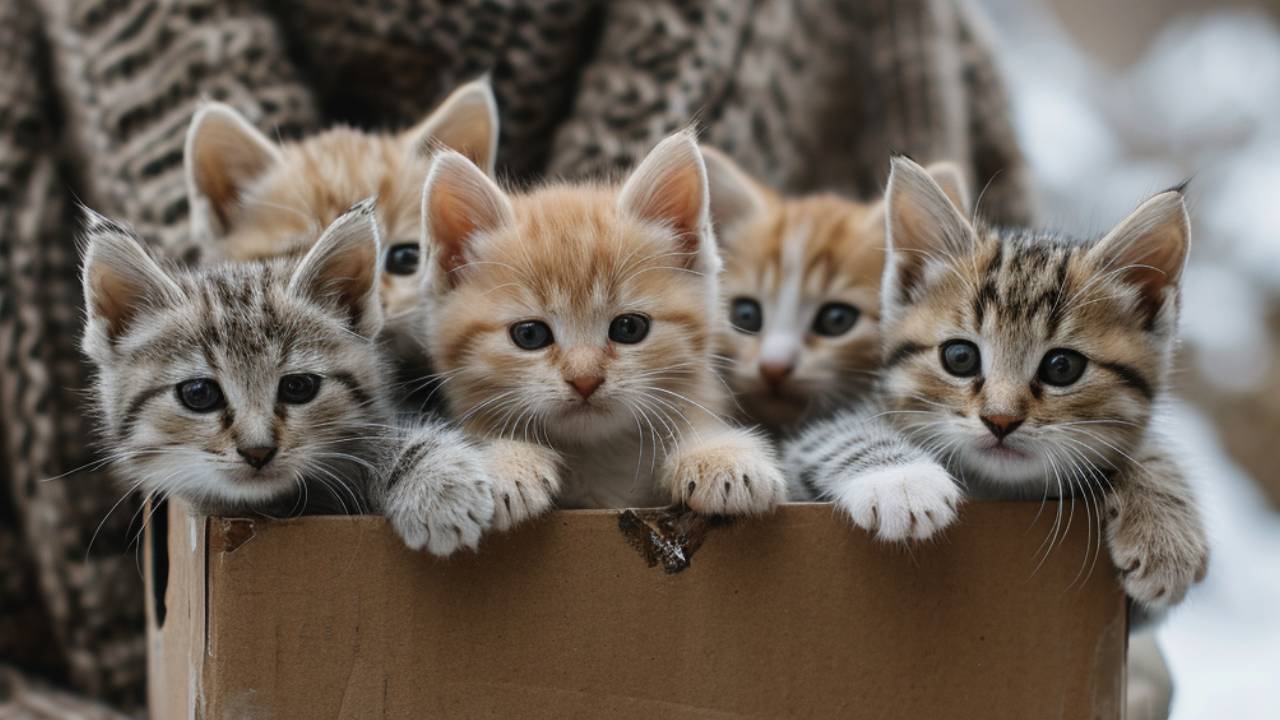Mark and his partner expected scratched furniture and chaos when they welcomed their first foster cat. Instead, they got a timid tabby named Olive, who needed patience more than anything else.
In just weeks, Olive began to trust again. “It changed how we see rescue work,” Mark shared. “To foster a cat is to heal by simply showing up.”
Their story and journey are truly inspiring, and if you’ve found this article, the American Paws Club team is here to help you every step of the way. Are you ready?
What It Means to Foster a Cat 🥰
When Olive stepped timidly into Mark’s home, she only needed a soft place to land and someone willing to meet her where she was. That’s what fostering really is.
Furthermore, fostering is about offering:
- Short-term care for a cat who isn’t ready for adoption yet
- A low-stress home that helps them recover
- Basic daily support, like feeding and observing their behavior
Unlike adoption, fostering is a temporary commitment. You’re helping prepare them for someone else who will, though some families eventually explore kittens available for adoption when the timing feels right.
This cat fostering guide exists to fill in the rest. We’re explaining how to get started, what to expect, and how to navigate both the easy days and the tougher ones.
Why Foster a Cat? The Emotional and Practical Benefits 🫂
While sharing your home with a foster cat, you might expect noise or mess. But in our experience, it’s the quiet moment that stays with you. It includes a cat that is finally coming out from under the bed, a slow blink from across the room, and a soft paw on your leg at breakfast.
It’s meaningful and a short-term commitment that leaves a long-term imprint.
The Emotional Benefits🤗
People often foster a cat, thinking they’re just helping the animal. But many discover they’re gaining something, too, such as:
- a sense of purpose that fits into everyday life;
- emotional connection without a permanent commitment;
- the joy of seeing progress, no matter how small; and
- a deeper understanding of animal behavior and trust.
The Practical Impact 🏠
When you foster a cat, you’re helping the system that surrounds them.
- Foster cat programs ease overcrowding in shelters
- They give animals a break from stress, helping them stay healthier
- Foster homes allow shelters to learn more about a cat’s personality, which makes adoption more successful
Related Post: 50+1 Reasons To Get A Cat
Preparing Your Home and Heart 🏠❤️
Preparing to foster a cat means preparing to let love in. And of course, to let it go. That can be the most challenging part, but it’s also what makes fostering so powerful. So, what do you need before your foster cat arrives?
The Basics: Setting Up Your Space 🧺
- A quiet area works great
- Food and water bowls
- A clean litter box
- A cozy resting place
- Toys and scratchers
For ongoing variety, a luxury subscription box for cats can keep new toys and treats coming, so your foster never gets bored.
Shelter Requirements You Should Know 📋
While every organization is different, most cat fostering requirements include:
- A home visit or virtual interview
- A stable, pet-safe environment
- Willingness to follow care instructions and give medication if needed
- Open communication and regular updates on the cat’s behavior or health
How to Foster a Cat: The Step-by-Step Journey 🐾
If you’ve made it this far, chances are your heart is already in the right place. Now it’s time to look at what fostering looks like, step by step.
1. Contact a Local Shelter or Rescue Organization 🚨
Reach out to local animal shelters or rescue organizations to express your interest in fostering a cat. They can provide you with information about their fostering program and the specific needs of the cats they have available.
2. Prepare Your Home 🏠
Set up a designated space for the cat with a comfortable bed, litter box, food and water bowls, and some toys. This will give the cat a safe and secure area to adjust to its new surroundings.
3. Gradual Introduction 🔎
Allow the cat to explore its new space at its own pace. Keep interactions calm and gentle. Spend time in the same room, but don’t force the cat to interact with you until it feels comfortable.
4. Provide Basic Needs 👌
Ensure the cat has a well-balanced diet suitable for its age and health. Provide fresh water daily and keep the litter box clean. Regular veterinary check-ups and vaccinations are also essential.
5. Socialization 🐱
Spend quality time with the cat, talking softly and offering gentle petting. Use toys to engage in interactive play. Socialization is crucial for helping the cat become more comfortable with humans.
6. Medical Care 🛡️
Keep an eye on the cat’s health and behavior. If you notice any signs of illness or distress, contact the shelter or rescue organization promptly, or consider getting quick help through an online vet consultation if it’s after hours.
7. Monitor Behavior 🤔
Cats may exhibit various behaviors during the fostering period. Some may be shy or fearful, while others may be more outgoing. Be patient and understanding, adapting your approach to the cat’s individual needs.

When is Fostering a Cat Impossible? 👇
Still, there can be situations when fostering these beautiful creatures is not possible. These instances usually include:
1. Aggressive or Dangerous Behavior 😼
Cats with a history of aggression or dangerous behavior may not be suitable for fostering, especially if you have children or other pets in your home. Aggressive behavior can pose risks to the safety of everyone involved.
2. Severe Medical Conditions ❤️🩹
Cats with severe medical conditions that require intensive and specialized care might be better suited for a foster home with individuals experienced in handling such cases. If you’re not equipped to handle a cat’s specific medical needs, it’s best to avoid fostering in such situations.
3. Highly Stressed Cats ❌
Some cats may be extremely stressed in new environments or around other animals. If you’re unable to provide a calm and quiet space for a cat that requires it, it’s best to avoid fostering in such cases.
4. Unvaccinated Cats with Infectious Diseases 💉
Cats with contagious diseases that can spread to other animals, such as feline leukemia (FeLV) or feline immunodeficiency virus (FIV), may not be suitable for fostering if you have other pets at home. It’s crucial to prioritize the health and well-being of all animals.
5. Lack of Time and Commitment 🕒
Fostering requires time, dedication, and a willingness to provide care. If you’re unable to commit to the responsibilities of fostering, it’s better not to take on the role. Fostering is a temporary commitment, but it still requires consistent care and attention.
6. Inexperienced Fosters for Neonatal Kittens 🤔
Neonatal kittens, being very young and often still requiring bottle feeding, require specialized care. If you lack experience in caring for neonates, it’s recommended to gain knowledge or seek guidance before fostering them.
7. Non-secure Living Environment 🤝❌
If your living environment is not secure, with potential hazards such as open windows, toxic plants, or other dangers, fostering may not be a good idea. Ensuring a safe space for the cat is essential.
Always communicate openly with the shelter or rescue organization about your capabilities, experience, and living situation, especially if you’re also exploring options beyond fostering, like working with verified cat breeders for long-term adoption.
The Ups and Downs: Challenges and Rewards 😻
There are moments when you’re cleaning up yet another accident or waking up at 2 a.m. to check if the kitten is breathing. And there are moments when you catch yourself smiling just watching them sleep.
The truth is, fostering brings a mix of soft wins and hard lessons.
The Tough Stuff (That No One Puts on the Flyer) 🐾
- Cats may hide for days. Or hiss. Or refuse to eat.
- Some kittens need round-the-clock feeding, every 2 to 3 hours.
- Medical surprises happen: diarrhea, colds, parasites, ringworm.
- Your own pets, if you have them, may need to be kept separate.
- Saying goodbye? Never easy.
Especially when you foster a kitten, the attachment builds fast. Their tiny paws, their round eyes, and the way they curl into you without hesitation all leave a mark. And letting go when they’re adopted can feel like heartbreak and pride at the same time.
Cat Foster Care Tips (from People Who’ve Been There)💡
Real foster families shared these reminders:
- “Set boundaries early—don’t let them free-roam until they’re confident.”
- “Use unscented litter. Trust me.”
- “A hiding cat isn’t a failing cat. Give them time.”
- “Keep your goodbye note short. You’ll cry either way.”
Some foster caregivers say they couldn’t do it again. And then, two weeks later, they’re back, because the quiet without a cat feels even harder. So, yes, many people foster a kitten more than once. Not because it’s easy, but because it’s worth it.
From Temporary Home to Forever Family 🐈
Every foster journey eventually reaches a moment when you realize your role was helping them move on. That’s the heart of any good foster cat program: building a bridge from fear or uncertainty to a home that’s filled with love.
Take Nina, for example.
She had never fostered before when she agreed to care for a mother cat and her three kittens. The kittens were underweight and skittish. One refused to be touched for the first week. But Nina gave them space. She played soft music. She sat on the floor and read aloud, letting them get used to her voice.
- By week five, they were climbing into her lap.
- By week seven, they were sleeping in a warm pile at her feet.
- By week ten, all three had been adopted, confident, social, and ready.
What Fosters Give Before They Say Goodbye 🐾
When you’re fostering kittens (or any cat, really), you’re shaping how they’ll interact with people for the rest of their lives. That might mean:
- Getting them used to household sounds
- Helping them explore without fear
- Teaching boundaries in play
- Noticing quirks that will matter to potential adopters
A Gift with Paw Prints 🐱
When Mark and his partner brought Olive home, they thought it would be difficult. They expected noise, broken furniture, and stress. But Olive was quiet. She stayed in one spot and avoided eye contact. She didn’t need much. Little by little, she began to trust them.
That experience changed how they saw rescue work. It showed them how small actions can lead to real change. To foster a cat is to offer something simple but powerful. A safe place. A gentle routine. A chance to rest before a new beginning. Even if it’s only for a short time, it leaves a lasting mark.
You don’t have to feel ready. Most people start with questions. What matters is that you care and that you’re willing to try.
At American Paws Club, we’re here to walk with you. You’ll find support, trusted resources, and local foster care programs to help you get started. Reach out anytime to talk to our team directly.
Are you ready?

FAQ
How do I become a cat foster parent?
Start by reaching out to foster-based organizations in your area. Most have a foster program in place. They’ll walk you through their application process and help match you with a cat that fits your home and lifestyle.
What supplies do I need for fostering a cat?
You don’t need much to get started. Just the basics: a litter box, cat litter, food and water bowls, cat food, a scratching post, some toys, and a cozy bed. Depending on the cat, grooming tools can also be handy.
How long does cat fostering usually last?
It depends on the cat and their situation. Some stay for just a few weeks. Others may need a few months before they’re ready for adoption. The organization will give you a general idea of what to expect when you begin.
What if I get attached to the foster cat?
It’s completely normal to get attached. Just remember, the goal is to help them find a loving forever home.
Can I adopt the cat I’m fostering?
Yes, sometimes you can. If you feel like your foster cat is already a part of your home, talk to the organization. Many foster programs are open to adoption when the fit is right.






0 Comments